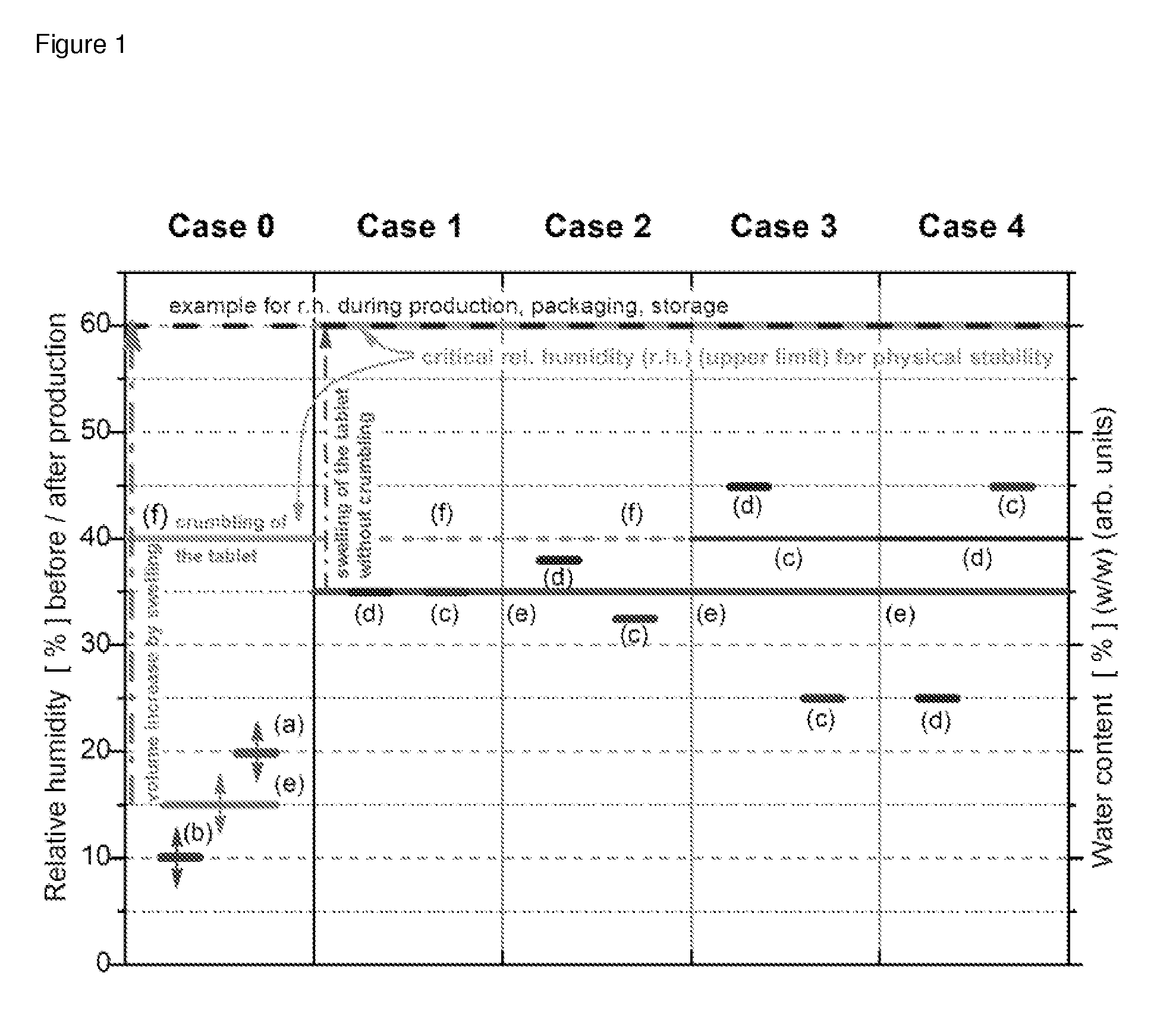Use of moisture-conditioned disintegrants or expanding agents in tablet manufacture for the selective adjustment of the mechanical properties, the dissolving kinetics and/or the water loading of the tablets
a technology of expanding agent and disintegrant, which is applied in the direction of pill delivery, animal husbandry, biocide, etc., can solve the problems of mechanical instability or fracturing of the tablet, the critical humidity level at which the tablet disintegrates can only be influenced very small, and the dissolution kinetics of the tablet are shifting into a very unfavourable range, so as to avoid adverse effects on the physical stability or storage qualities of the formulation, widen the relative humidity and temperature range of production
- Summary
- Abstract
- Description
- Claims
- Application Information
AI Technical Summary
Benefits of technology
Problems solved by technology
Method used
Image
Examples
example 1
[0028]Properties of the formulation components before tabletting: all the components of the tablet, i.e. disintegrant and active substance (including any other adjuvants) are unconditioned.
[0029]A tablet “T1” is prepared with an unconditioned, i.e. dry, non-preswollen disintegrant+active substance and in a climate of e.g. 25° C. / 60% r.h.
[0030]T1 absorbs a relatively large amount of water, and disintegrates prematurely as a result of the excessive swelling of the disintegrant, i.e. at too low a relative humidity or too rapidly in the range of a critical r.h. The disadvantages of this conventional procedure are the often premature fragmentation of the tablet (i.e. damage even at low relative humidity levels, critical limit here e.g. 40% r.h.) and / or fluctuations in the quality of the tablet in terms of its mechanical stability, e.g. due to variations in the initial humidity and therefore variations in the absorption of moisture (=swell reserve) up to the point of disintegration.
example 2
[0031]By comparison, a tablet “T2” is produced with a disintegrant preconditioned to a specific relative humidity. As a result of the preswelling of the disintegrant caused by its moisture conditioning the additional swelling during storage (in this case e.g. 60% r.h. / 25° C.) is less than in T1 and thus the disintegration forces in T2 are also less than in T1. The disintegration thus only occurs at a higher relative humidity, compared with Example 1, and possibly only after a time delay. In addition, the relative humidity beyond which the disintegration of or damage to the formulation takes place can be (selectively) adjusted by the choice of the conditioning humidity of the components (active substance and / or disintegrant), and hence by their swell volume. Moreover, in this way, the delay in disintegration can be selectively adjusted. Thus, this method can also be used to produce delayed-release pharmaceutical preparations. This and the possibilities arising from it for improved ta...
example 2a
[0032]Properties of the formulation components before tabletting: all the components of the tablet, i.e. disintegrant and active substance (including any other adjuvants) are conditioned to the same specific relative humidity, and both conditioning processes are below a specific critical limit (in this case e.g. 40% r.h.).
[0033]One advantage of this procedure according to the invention is:
[0034]i) during production, packaging and / or storage under specific climate conditions (in this case e.g. 60% r.h.), the disintegrants is preswollen during tabletting, i.e. a higher humidity is needed to develop the disintegrating force. Therefore the tablet remains mechanically stable up to a high humidity.
[0035]Other advantages of this procedure according to the invention are:
[0036]ii) By the choice of the relative humidity of the conditioning of the components, particularly of the disintegrant, matched to other influencing factors in the tabletting (tablet punch, pressure-time profile) the time ...
PUM
| Property | Measurement | Unit |
|---|---|---|
| water content | aaaaa | aaaaa |
| humidity | aaaaa | aaaaa |
| humidity | aaaaa | aaaaa |
Abstract
Description
Claims
Application Information
 Login to View More
Login to View More - R&D
- Intellectual Property
- Life Sciences
- Materials
- Tech Scout
- Unparalleled Data Quality
- Higher Quality Content
- 60% Fewer Hallucinations
Browse by: Latest US Patents, China's latest patents, Technical Efficacy Thesaurus, Application Domain, Technology Topic, Popular Technical Reports.
© 2025 PatSnap. All rights reserved.Legal|Privacy policy|Modern Slavery Act Transparency Statement|Sitemap|About US| Contact US: help@patsnap.com

